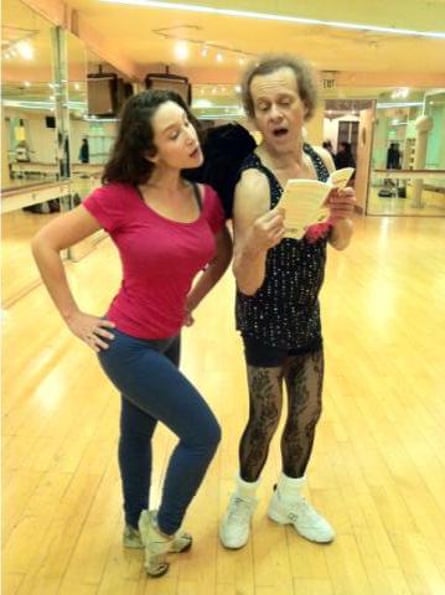For as long as I lived in Los Angeles, I was looking for the angels of its name. The mural of the Virgin Mary above the local ATM. The ongoing saga of the Silver Lake convent over which pop star Katy Perry was in a legal battle with nuns. There was the Apache psychic who called, “Archangel Michael, guide us!” from the back room of her husband’s boxing studio in the Valley. And the movie star who rescued the worst of the worst addicts – people in the industry whisper “He’s a saint!”
Though instantly recognisable for his halo of hair, Richard Simmons, who arrived in the city in the 1970s, emerged too strongly from the realm of camp to receive nomination to sainthood. Once he gave up dreams of acting, he’d make his name through his Sweatin’ to the Oldies aerobics videos, his place in 80s pop culture recreated by The White Lotus’s Murray Bartlett in the most recent season of Apple’s exercise dramedy, Physical. Through the decades Richard was so famous he appeared regularly on David Letterman and Howard Stern, and guested on shows from CHiPs to Arrested Development. It was easy for contestants to “become” him on RuPaul’s Drag Race because his signature upbeat energy was so extreme as to appear deranged. His short shorts and tights, combined with the way his female followers loved him as they had Liberace, made him mockable in TV sketch shows. But from the moment I met him, I believed he was a kind of saint.
I was engaged to an actor who lived in a guest house with a stone angel overlooking the city, the view across Mulholland Drive as mesmerising as he was. When we met, I was paying a ton to work out with a handsome celebrity trainer who had me pull tyres up and down a track until I had his signature bubble butt. But, in the months before my wedding, I’d come in shaking from arguments, unable to stop crying. We sat on the tyres instead of pulling them up the track.
“You can’t get married,” he told me.
Once someone has said that out loud and you’re not able to take their advice, you can’t go back. I told myself he was just too good looking to keep training with.
Richard Simmons had been one of the very first to “brand” himself, but, as I cast around for a new workout, it was a surprise to find his gym, Slimmons, was still open after 40 years, still offering twice-weekly aerobics classes with the man himself. The gym was a bare-bones auditorium, his classes cheap as chips and, most significantly, if you were too overweight or old to exercise standing up, he would provide a chair. There were mirrors but no mirror faces. Until Slimmons, gyms were only for people who were already in shape. Not only did he answer all fanmail and emails himself, but Richard, who made hundreds of millions of dollars from his workout tapes, regularly drove elderly attendees to class.
Born in 1948, he was overweight by the age of four, and by five knew his weight was perceived negatively. As an adult, he wanted to act but only played “freak show” characters in Fellini’s Satyricon and The Clowns, reaching a peak of 121.5kg. On losing 45kg, he turned to sharing his aerobic journey professionally. The origin story of Hollywood stars is often people arriving there from puritanical places – Judy Garland from Minnesota, Brad Pitt from Missouri. It could be argued that Hollywood is rigid compared to growing up in New Orleans, where Richard’s Russian Jewish mother had been a travelling fan dancer.
On setting foot in his class, I recognised Richard as a particular kind of Jewish man from my family tree. He was cut from the same cloth as my dad, running up and down the stairs carrying the cat on a throne made from a basket of folded laundry, or Uncle Len guiding us, skipping, through the cemetery on Halloween. I recognised in him the combination of manic and warm. I knew, by the end of my first session, that the highest honour was if Richard came close and shrieked in your face. From someone so inherently warm, it was like an ice bath from one of LA’s famous Koreatown spas: alarming, invigorating and value for money.

After that first class, like everyone else, I lined up to have my picture taken with him. I gave him a book of mine I thought he’d like, and he posed, gasping at the content as if scandalised. I took photos with him a few times after that, then I realised I wouldn’t need to do that every week. A successful week was when I saw both Richard and my beloved therapist, the only one I’ve ever had to talk Aboriginal dream theory in sessions.
Exercise has always been about mental health to me, something I struggled with in my teens and early 20s. The irony is that what drew me to Richard was the way he seemed to do jumping jacks atop a lava beneath which lay complete madness. I thought of Bob Dylan’s Isis: “What drives me to you is what drives me insane.” I couldn’t imagine Richard ever listening to Dylan, or any music that didn’t feel related to an epileptic fit. If I could encapsulate all my classes into one moment, it’s doing the grapevine to a hi-NRG remix of My Heart Will Go On, a 90-year-old side-eyeing me to make sure I wasn’t moving in on her spot in the front row, Richard screaming in aerobic delirium, dressed as Black Swan. He wore too many costumes to list but I particularly remember a Highland Fling tartan and an outfit made from sporks.
I took my fiancé, Ben, to a class, charmed he was happy to take part in this absurd and absurdist 90 minutes. When Ben (who is not a gym person) was overwhelmed, Richard flipped his dentures at him to make him laugh. Afterwards we talked about the scent of Richard’s pancake makeup, as distinctly LA as jacaranda flowers and tacos. That Richard made you laugh when you were struggling felt akin to longterm love in action.
On 15 February 2014, Richard didn’t show up for his class and never came back again. His devastated followers eventually had police do a senior welfare check. The police reported he was alive, he just didn’t want to be a public figure any more. As anyone who has ever been ghosted can attest, the absence of an answer can be a shock that leads to obsessive rumination. Mauro Oliveira, his former massage therapist, said Richard’s longtime housekeeper, Teresa Reveles, was controlling him through witchcraft – Richard denied this in a radio interview. He sued the National Enquirer when it said he was transitioning to female. Rumours abounded that a knee injury had sunk him into depression. The podcast Missing Richard Simmons, released in 2017 by Dan Taberski (such a devoted attendee of class that he had dined at Richard’s home), tried to uncover what happened, but it didn’t, as had been Taberski’s hope, cause Richard to appear. Richard’s brother, Lenny, eventually spoke to Taberski, saying he sees him at holidays and he just wants to be left alone. “Is he happy and healthy?” Lenny paused: “Happy is a hard word to describe. There’s nothing going on medically”.
READ RELATED: Skin Purging vs. Breaking Out: Experts Explain the Difference
Two things troubled Richard followers: that, having given us so much, he deserves goodness and kindness; and that having offered us goodness and kindness, he ought not so suddenly switch it off. When I got married and my husband would go through periods of not talking to me, I would follow him from room to room, pleading, “What is it, what is it? What did I do, please tell me?” I’d insist he share what was bothering him. He felt persecuted by my concern and I felt abused by his silence.
That time he came to Richard’s class, a lady started filming us for one of the gym’s promotional videos. Realising this, Ben, who’d been participating with enthusiasm, said, “No I can’t be filmed, I’m a villain in a Batman movie,” and tried to sneak out. But Richard saw him leave, and shape-shifted to my side. “What’s he doing?” I tried to explain: “He’s a villain in a Batman movie that’s coming out and…” Richard’s face fell and the rat-a-tat shriek of his voice seemed to sink through molasses. He was crushed. As if overweight women romantically idolising you when you are wearing an outfit made from sporks meant you were a joke.
Something I liked about Richard’s classes was that his actual exercises were basic and repetitive, jumping jacks and push-ups. I think their quotidian nature, in contrast to his eccentricity, helped foster stability, the way doing household chores can free your mind of worry. What I’d suffered with, before I found the right psychiatrist and medication, and committed to exercise, was rapid-cycle manic depression. It would change in an hour and sometimes a half hour. Ecstatic joy and optimism and crashing despair and then back again. Projecting my own difficulties, as all audiences do to their favourite stars, the possibility occurred to me that Richard might have been having a decades-long manic fit. Do you know how hard it is to be crazy and then have a window of insight that you are not well? All the things I did when I was manic felt so wonderful when I was doing them. Mania was the superhero me. The comedowns were the prison.

There is only one harbinger I can see when I look through his public record. In 2004, Richard had slapped a man at Phoenix Airport who’d said: “Hey everyone it’s Richard Simmons! Let’s drop our luggage and rock to the 50s!” I remembered how, one time, when they wouldn’t give me my medication at the pharmacy because of an insurance issue, how badly I’d lost it in public. It was the Britney Spears 24-hour pharmacy in the Valley, the one that she’d go to in the wee hours after she’d been driving around all night.
Britney also likes to post exercise videos now she’s “free”. If there’s anxiety you cannot bear to carry inside your body, working out can stave it off. But only while you’re in it. Richard had the lightest touch, the only exercise guru who did it with humour and self-deprecation. No one knows what he looks like now, in his mansion, behind the newly gated drive.
I went with my whole family back to class two days before my wedding. Ben came back in to say hello at the end and made it right with Richard. I knew things were right because Richard kept coming up in his face and screaming “Remember to brush your teeth before the ceremony!” And making the tooth-brushing gesture across the room whenever he caught his eye.
One of my best friends cut ties with me 10 years ago. He never told me why and I turned it over in my head endlessly. Recently, when I prodded her, a wise mutual friend told me, in a very kind way, why: my ex-friend didn’t think writers should publish memoirs. It bothered him that I had. It didn’t matter that I held myself accountable, the act of recounting these things in public without distilling them through the lens of imagination was, he felt, beneath me as an artist. That’s interesting, I thought. I don’t agree but that’s an answer! I felt a lot better.
Once Richard was gone, I worked with other instructors at new studios, some totally different – Marnie, so beautiful and ethereal, Audrey, an adorable tomboy Jock – and some too similar, like Hector, who would scream “SHAKE YOUR BOOBS!” – only it rang hollow, somehow.
If Richard came down from the hill, he’d see a lot of LA is boarded up post-pandemic, coyotes roam the streets in packs during the day, the homeless are thrown away. Katy Perry won the legal action. One of the nuns died in court during a hearing. Why does Katy want a convent? We all want elevation wherever we can get it, from the vast California sky, or from a cramped exercise class.
The most important thing I learned from Richard Simmons is you can be ridiculous and significant, silly and a spiritual guide. Back in London, post-divorce, I sometimes watch Sweatin’ To The Oldies on YouTube. I am not old, but old enough that when I am stressed or sad it manifests in my body. My now ex-husband and I can go long periods without talking before texting each other out-of-context song lyrics from our youth as proof of life. I want to talk to my beloved therapist, the one who used to chat dream theory. But he is one of many healers who was so badly affected by the isolation of Covid that he quit his work and left town. His patients sometimes text him, just to tell him what he meant to us. He doesn’t reply. But we can, at least, see that the messages have been read.
Emma Forrest’s memoir Busy Being Free (Weidenfeld & Nicolson, £9.99) is out in paperback this week





